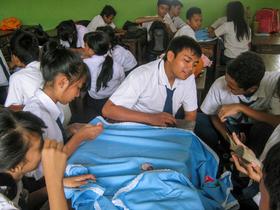Top Rankings
Sahuarita Unified District (4411) ranks among the top 20% of public school district in Arizona for:
Category
Attribute
Graduation Rate
Highest graduation rate (Top 10%)
Community Size
Largest student body (number of students) (Top 1%)
For the 2025-26 school year, there are 3 public high schools serving 2,435 students in Sahuarita Unified District (4411). This district's average high testing ranking is 7/10, which is in the top 50% of public high schools in Arizona.
Public High Schools in Sahuarita Unified District (4411) have an average math proficiency score of 31% (versus the Arizona public high school average of 35%), and reading proficiency score of 43% (versus the 45% statewide average).
Public High School in Sahuarita Unified District (4411) have a Graduation Rate of 89%, which is more than the Arizona average of 78%.
The school with highest graduation rate is Walden Grove High School, with 90% graduation rate. Read more about public school graduation rate statistics in Arizona or national school graduation rate statistics.
Minority enrollment is 67% of the student body (majority Hispanic), which is more than the Arizona public high school average of 65% (majority Hispanic).
Overview
This School District
This State (AZ)
# Schools
10 Schools
947 Schools
# Students
6,431 Students
440,682 Students
# Teachers
350 Teachers
15,905 Teachers
Student-Teacher Ratio
18:1
18:1
Student By Grade
District Rank
Sahuarita Unified District (4411), which is ranked within the top 50% of all 601 school districts in Arizona (based off of combined math and reading proficiency testing data) for the 2022-2023 school year.
The school district's graduation rate of 89% has increased from 86% over five school years.
Overall District Rank
#175 out of 618 school districts
(Top 30%)
(Top 30%)
Math Test Scores (% Proficient)
38%
34%
Reading/Language Arts Test Scores (% Proficient)
47%
40%
Science Test Scores (% Proficient)
26%
24%
Graduation Rate
89%
77%
Students by Ethnicity:
Diversity Score
0.55
0.66
% American Indian
1%
5%
% Asian
1%
4%
% Hispanic
60%
46%
% Black
2%
6%
% White
31%
35%
% Hawaiian
n/a
n/a
% Two or more races
5%
4%
All Ethnic Groups
District Revenue and Spending
The revenue/student of $10,139 in this school district is less than the state median of $11,429. The school district revenue/student has declined by 12% over four school years.
The school district's spending/student of $8,794 is less than the state median of $11,331. The school district spending/student has declined by 12% over four school years.
Total Revenue
$65 MM
$12,837 MM
Spending
$57 MM
$12,727 MM
Revenue / Student
$10,139
$11,429
Spending / Student
$8,794
$11,331
Best Sahuarita Unified District (4411) Public High Schools (2025-26)
School
(Math and Reading Proficiency)
(Math and Reading Proficiency)
Location
Quick Facts
Rank: #11.
Sahuarita High School
(Math: 36% | Reading: 45-49%)
Rank:
Rank:
7/
Top 50%10
350 W Sahuarita Rd
Sahuarita, AZ 85629
(520) 625-3502
Sahuarita, AZ 85629
(520) 625-3502
Gr: 9-12 | 1,181 student Student-teacher ratio: 20:1 Minority enrollment: 68%
Rank: #22.
Walden Grove High School
(Math: 28% | Reading: 40-44%)
Rank:
Rank:
6/
Top 50%10
15510 S. Sahuarita Park Rd
Sahuarita, AZ 85629
(520) 625-3502
Sahuarita, AZ 85629
(520) 625-3502
Gr: 9-12 | 1,154 student Student-teacher ratio: 23:1 Minority enrollment: 67%
Rank: #33.
Sahuarita Digital Pathways Academy
(Math: 25-29% | Reading: 35-39%)
Rank:
Rank:
6/
Top 50%10
350 W Sahuarita Rd
Sahuarita, AZ 85629
(520) 625-3502
Sahuarita, AZ 85629
(520) 625-3502
Gr: K-12 | 100 students Student-teacher ratio: 11:1 Minority enrollment: 62%
Recent Articles

Charter Schools vs Public Schools 2025: Key Differences & Trends
Explore updated 2025 insights comparing charter schools vs public schools, enrollment, academic outcomes, funding, and real-world examples for families and educators.

Are Public Schools Ready for the 21st Century? 2025 Update
Explore 2025 insights on whether public schools are ready for the 21st century, covering performance, technology, equity, funding, and future-ready learning.

Public School Open House & Enrollment Season Guide
A parent-focused guide to the public school open house and enrollment season, with expert questions, timelines, and decision tips.





